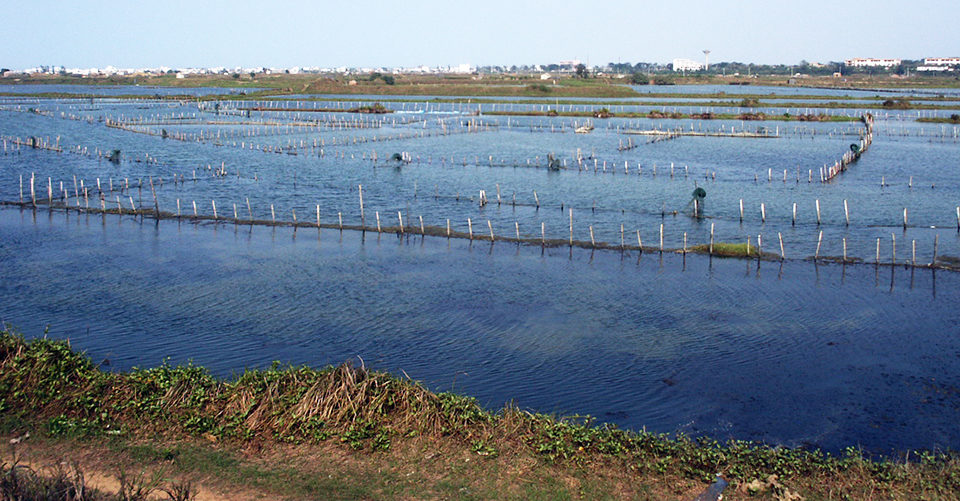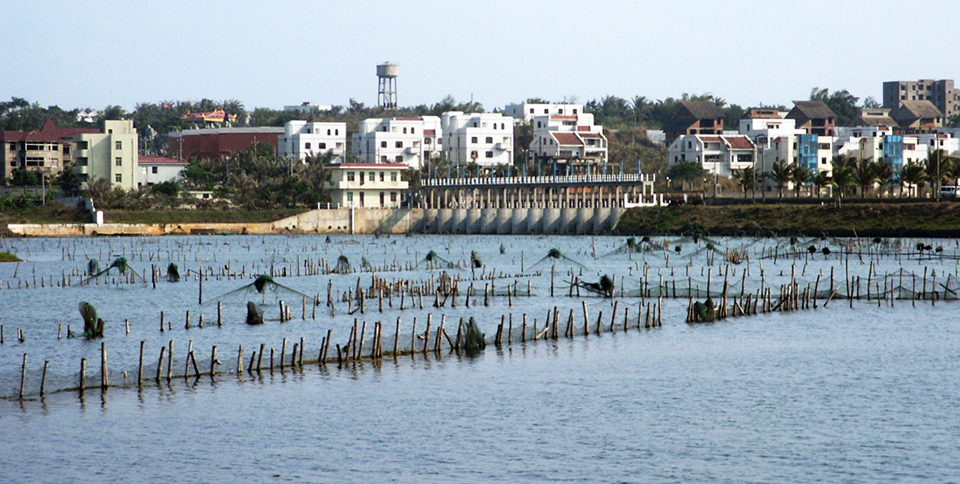Evaluating practices in Yingbin Bay, China

As global aquaculture production continues to increase, researchers and farmers are exploring ways to integrate a variety of low-trophic organisms, such as seaweed and bivalves, into culture of shrimp and other high trophic-level species to reduce the negative environmental effects associated with intensive aquaculture.
Such integrated aquaculture practices are not new. They have been used for thousands of years. While the commercialization of aquaculture has caused dramatic changes to and intensification of culture practices, contemporary aquaculture researchers and practitioners can learn a great deal from the design and implementation of traditional integrated aquaculture practices.
In a study, the authors collaborated with local farmers at Yingbin Bay in China’s Hainan Province, both to conduct water and sediment quality studies in and around several integrated farms during a single three-month grow-out season, and to administer a socioeconomic survey to local farmers. Two types of integrated aquaculture systems were examined: an intensive operation utilizing shrimp and abalone and a semi-intensive farm utilizing shrimp, seaweed and ducks.
Large-scale integration
Yingbin Bay is long and narrow, and located just west of Haikou City. The bay has been altered hydrologically by a dam constructed approximately 4 to 6 km upstream from its confluence with the Qiongzhou Strait. This dam created an 8,500-km2 brackish water lagoon in which a variety of aquaculture activities takes place, including shrimp, duck, abalone and seaweed farming.
The bay is fed from the northwest by runoff from rice farms through a straightened channel. There are many additional surface and groundwater water sources, and innumerable nutrient sources, including sewage and farm runoff. While the original characteristics of the bay are unknown, it is likely it was formerly fringed with mangrove forests.
While some shrimp farmers in the area have access to clean groundwater, many do not. To improve water quality for shrimp, they integrate culture of seaweed (primarily Gracilaria verrucosa) and abalone into their farming systems. The farms cycle pond water through seaweed ponds prior to using it for shrimp grow-out. The seaweed is used or sold for abalone production.
Collectively, the farmers in Yingbin Bay have created a large, integrated culture system that is effective in reducing concentrations of some nutrients. Over 150 ponds line the sides of the lagoon, and a large, open seaweed-only farming area is located just upstream of the dam. Thus, water discharged from ponds upstream is filtered by seaweed prior to exiting the lagoon.
Water quality
Both the semi-intensive and intensive integrated systems examined in the study maintained adequate water quality for shrimp production. Interestingly, data from the seaweed-farming area indicated that water quality did not decline over the approximately 11.5 km from the upstream-most sampling site to the dam downstream, despite the plethora of duck and shrimp ponds in the area.
Phosphate and total ammonia concentrations were consistently lower at the seaweed farms than they were at upstream sites. Nitrite concentrations were also lower downstream sites, although the reductions were not as striking. There was no reduction observed in chemical oxygen demand, total suspended solids and total phosphorus concentrations. In fact, these parameters were occasionally higher at downstream sites.
More detailed study of Yingbin Bay is necessary in order to determine the nature of these water quality improvements, water circulation in the bay and the role that integrated aquaculture may play in improving water quality there.
Integrating socioeconomics
Socioeconomic data collected from 22 interviews with local shrimp-only, seaweed-only, shrimp-seaweed and shrimp-duck farmers provided an interesting perspective on aquaculture in Yingbin Bay. Some farmers on Yingbin Bay believed strongly that integrated aquaculture both improved water quality and led to better production rates for all species involved. The survey results also indicated that farmers were aware of negative environmental conditions in the bay and were interested in finding ways to resolve these environmental problems.
Those who completed the survey tended to be small-scale farmers who owned or managed a few ponds. Shrimp-only farmers had, by far, higher gross incomes than any other farmers. While shrimp-seaweed farmers estimated they produced 9,000-22,500 kg shrimp/ha/year, shrimp-only farmers estimated they produced 10,500 kg/ha/crop. Thus, shrimp-only farmers produced as much shrimp in one three-month crop as some shrimp-seaweed farmers produced in one year.
Moreover, shrimp-only farmers produced more crops per year than shrimp-seaweed farmers and sold their shrimp at a higher price. The additional profit that shrimp-seaweed farmers made from seaweed production was not enough to equal that of shrimp-only farmers. Therefore, the economic incentive for shrimp monoculture still exists. It is possible that less-intensive integrated systems are used primarily by those who do not have or cannot afford access to the clean groundwater sources that would allow intensive shrimp-only production.

Seaweed shift?
Interestingly, casual conversations with farmers suggested they were beginning to perceive farming seaweed as providing less risk and more consistent profits than farming shrimp. This is surprising, given that, according to survey results, shrimp farmers generally made much more money than seaweed farmers.
The incidence of white spot syndrome and other viruses appeared high in Yingbin Bay, while the abalone farms that purchased seaweed as feed were doing quite well. Thus, the certainty of profit and low costs associated with seaweed – should the abalone farms continue to do well – might sway even more farmers toward seaweed in the future. Water quality in the bay could benefit as a result.
Clearly, the integration of seaweed and abalone farming into the aquaculture systems surrounding Yingbin Bay has not solved all water quality problems in the bay and surrounding region. However, Yingbin Bay, as a whole, is a hopeful example of the potential positive environmental and socioeconomic effects of integrated aquaculture when implemented on a large scale.
Building on tradition
The negative effects of intensive aquaculture systems on biodiversity and ecological health are frequently cited and discussed, and aquaculture has not had a good environmental image in some regions and instances.
However, the ecological data suggested that farmers on Yingbin Bay used integrated culture techniques with some success to grow high-trophic-level organisms that require good water quality, such as shrimp. Increased focus on developing traditional integrated aquaculture systems such as those utilized in Yingbin Bay could assist in ongoing efforts to increase the sustainability of aquaculture systems, improve environmental quality and change public perceptions about aquaculture.
(Editor’s Note: This article was originally published in the November/December 2012 print edition of the Global Aquaculture Advocate.)
Authors
-
Lauren Bennett
Advisory Council Coordinator
Olympic Coast National Marine Sanctuary
115 East Railroad Avenue
Port Angeles, Washington 98362 USA[109,111,99,46,108,105,97,109,103,64,116,116,101,110,110,101,98,46,116,109,108]
-
Dr. James Diana
Professor and Director
Michigan Sea Grant
University of Michigan School of Natural Resources and Environment
Ann Arbor, Michigan, USA -
Dr. Lai Qiuming
Professor
College of Aquaculture
Hainan University
Haikou, Hainan Province, China
Tagged With
Related Posts

Responsibility
A look at integrated multi-trophic aquaculture
In integrated multi-trophic aquaculture, farmers combine the cultivation of fed species such as finfish or shrimp with extractive seaweeds, aquatic plants and shellfish and other invertebrates that recapture organic and inorganic particulate nutrients for their growth.

Responsibility
A look at various intensive shrimp farming systems in Asia
The impact of diseases led some Asian shrimp farming countries to develop biofloc and recirculation aquaculture system (RAS) production technologies. Treating incoming water for culture operations and wastewater treatment are biosecurity measures for disease prevention and control.

Health & Welfare
A holistic management approach to EMS
Early Mortality Syndrome has devastated farmed shrimp in Asia and Latin America. With better understanding of the pathogen and the development and improvement of novel strategies, shrimp farmers are now able to better manage the disease.

Health & Welfare
A study of Zoea-2 Syndrome in hatcheries in India, part 2
Indian shrimp hatcheries have experienced larval mortality in the zoea-2 stage, with molt deterioration and resulting in heavy mortality. Authors considered biotic and abiotic factors. Part 2 describes results of their study.


